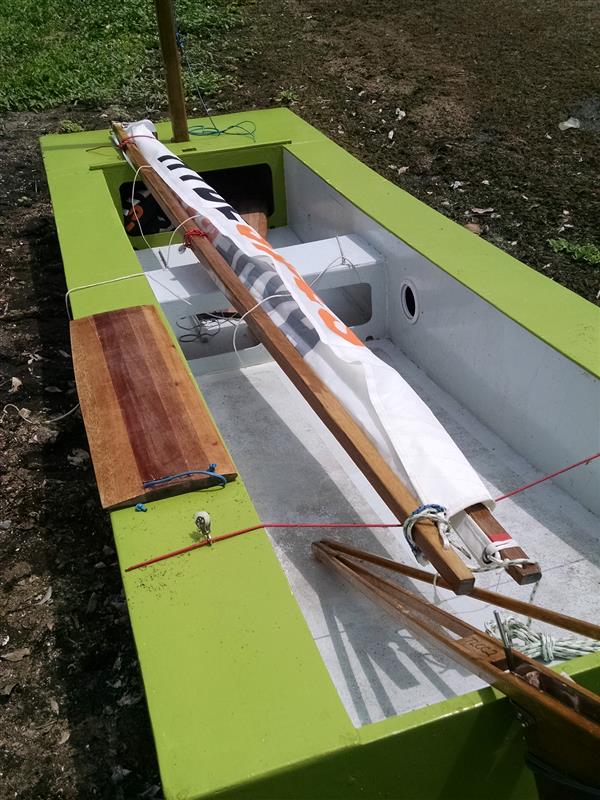From the OzRacer Archive.
How light is too light?
Because our boats were going to be built of much thinner ply they were going to weigh much less.
Some on the PDRacer forum were concerned that our OzRacers would not be strong enough.
Others took a more lateral thinking approach with the suggestion the sailor was a better source of weight reduction.
Could a diet make the boat faster?
One of the forum members suggested that we go on diets!
At least our problems are not of the same scale as for the tiny Cape Cod Frosty class.

Diet?
That could take weeks!!!!!!! Much easier to build the boat light.
And a light boat can carry more beer with less degrade in the performance. Now THERE’S
an incentive!!!
Quote from Forum: While weight is a consideration, so is resistance to oil canning and torsional rigidity. Oil canning will slow you down, and the wracking forces exerted by the sails pushing against the blades can twist a hull requiring more rudder to hold a course–also slow.
Oil canning (inadequate panel stiffness) or twist are problems that can be resolved through structural efficiency. The materials can still be very light.

There are many boats that carry much greater torsional loads (bigger masts and sails, crews on leaning planks or wings) with no problems. The picture on the right is lifted from the sailing videos of the boat going upwind in around 13 to 15 knots – at times the sailor (me) is at full stretch (for me – I am getting older) and exerting the maximum righting moment and thus the greatest load on the mast. Note that there is no visible twist in the hull.
We also know the most common ply thickness right across the range of Australian plywood boats is 4mm or 3/16″.
And that average hullweights are 8 to 10lbs per foot of length.
This means 8ft dinghies the antipodean way would come out around 64 to 80lbs. We hit the 64.
And that 12ft boats would come out around 96 to 120lbs. Again we achieved that as standard.
Going back to stiffness …
We did take a photo of the boat standing in the driveway with Peter and I standing on diagonally opposite corners of the boat. – much greater twisting load than will be experienced when sailing – and no visible flex.
They also go a lot faster so there are big slamming loads to test the panel stiffness. – some will manage bursts of 15 to 18 knots (International Canoe, International Moth and many others). Slamming loads are proportional to the square of the speed (ie kinetic energy) – so these boats are generating 25 times the panel loads of the Puddle Duck
Our boats have come out of three sheets of ply – no extras – are fabulously torsionally rigid and the hull panels are adequately stiff despite being built of 3/16 (4mm) ply. (as a previous post pointed out a few dollars extra to get 1/4 inch – 6mm – ply would have eliminated the need for bottom runners in timber – a better choice, but the rest can still be 3/16 without any problems.


Moth Class dinghies (pics above) in Australia and the UK were built of 1/16 ply and display no significant torsion while sailing despite 20ft masts and the crew perched on wings 5 ft from the centreline – rather than the 2ft of the puddleducks.
In the case of the OZ Racers the bases of the rigidity are the three buoyancy tanks which as closed boxes are tremendously resistant to bending and torsional loads.

These make up a substantial proportion of the length of the boat.
There is only about 2 1/2 ft (750mm) of boat that is not so braced – but the side decks and centrecase structure is used to prevent the rectangular cross section in that area from distorting, so providing a girder that links the front box with the two aft ones.
Before the boxes got their permanent lids the boat was really prone to twisting. Whack the tops on and it is a different beast.
Goose has two long torsion boxes down both sides. Mk1 Goose

Mk 5 goose

Rigidity is not about weight it’s about structural efficiency.
Forum Quote: If you want to tune a boat within the rules, you can play with the tolerances to adjust the rocker in the bottom (though I don’t have a clue as to what sort of tweeking would be most beneficial) and experiment with different sails. I think either of these is likely to be more effective then trimming a few pounds from the hull.
We have done all of them – so why not look at weight as well?
It doesn’t add more work – apart from the thinking – it makes the boats easier to lug around on shore and easier to lift for when the neighbours’s kids want to borrow the boats.
Lighter materials and less timber also save cost generally.
In the end we all build the sort of boats we imagine – as the wide range of puddle ducks displays – a variety mind numbing compared to the narrow views of the more conventional sailing classes.
Each to their own. :-) As you say – we get excited about all this stuff. We are having heaps of fun – you should see the reflections in the surfaces of the centreboards and rudders that I coated last night. The hollow tapered timber masts are looking pretty too.
Best Regards
Michael Storer
More information about the Oz Goose sailing dinghy here.